|
|
|
Sort Order |
|
|
|
Items / Page
|
|
|
|
|
|
|
| Srl | Item |
| 1 |
ID:
141029
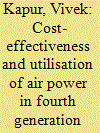

|
|
|
| 2 |
ID:
191918
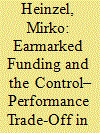

|
|
|
|
|
| Summary/Abstract |
Since the 1990s, the funding of multilateral development assistance has rapidly transformed. Donors increasingly constrain the discretion of international development organizations (IDOs) through earmarked funding, which limits the purposes for which a donor's funds can be used. The consequences of this development for IDOs’ operational performance are insufficiently understood. We hypothesize that increases in administrative burdens due to earmarked funding reduce the performance of IDO projects. The additional reporting required of IDOs by earmarked funds, while designed to enhance accountability, ultimately increases IDOs’ supervision costs and weakens their performance. We first test these hypotheses with data on project costs and performance of World Bank projects using both ordinary-least-squares and instrumental-variable analyses. We then probe the generalizability of those findings to other organizations by extending our analysis to four other IDOs: the African Development Bank (AfDB), Asian Development Bank (ADB), Caribbean Development Bank (CDB), and International Fund for Agricultural Development (IFAD). Using data on the performance of 7,571 projects approved between 1990 and 2020, we find that earmarked funding undermines both cost-effectiveness and project performance across IDOs. Donors seeking value for money may consider allocating more money to core funds rather than to earmarked funds.
|
|
|
|
|
|
|
|
|
|
|
|
|
|
|
|
| 3 |
ID:
192761
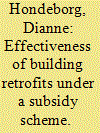

|
|
|
|
|
| Summary/Abstract |
While retrofitting buildings is one of the key elements of reaching climate and energy goals, it is burdened by insufficient speed and depth. Governments have attempted to accelerate deep retrofits via subsidies, but scant evidence exists on these policies’ effectiveness. In this study, we investigate the effectiveness of retrofitting subsidies by using a range of econometric techniques and a unique dataset of over 400 Swiss buildings with 19,000 observations over 11 years. Specifically, we analyze whether retrofits reduce energy consumption, whether subsidized retrofits lead to deeper retrofits than non-subsidized retrofits, and we differentiate the impact by subsidy amount. We find that retrofits reduce average energy use by 10–20%, that the achieved savings through subsidized and non-subsidized retrofits do not differ significantly, and that the subsidy amount is correlated to a reduction in energy use by 0.42 CHF per kWh over a period of 20 years. Our study highlights the importance of policies that enhance retrofit depth, the need to further investigate the causes of the wide variation in retrofitting results, and to consider effectiveness studies within the policy design.
|
|
|
|
|
|
|
|
|
|
|
|
|
|
|
|
| 4 |
ID:
191366
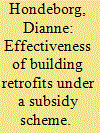

|
|
|
|
|
| Summary/Abstract |
While retrofitting buildings is one of the key elements of reaching climate and energy goals, it is burdened by insufficient speed and depth. Governments have attempted to accelerate deep retrofits via subsidies, but scant evidence exists on these policies’ effectiveness. In this study, we investigate the effectiveness of retrofitting subsidies by using a range of econometric techniques and a unique dataset of over 400 Swiss buildings with 19,000 observations over 11 years. Specifically, we analyze whether retrofits reduce energy consumption, whether subsidized retrofits lead to deeper retrofits than non-subsidized retrofits, and we differentiate the impact by subsidy amount. We find that retrofits reduce average energy use by 10–20%, that the achieved savings through subsidized and non-subsidized retrofits do not differ significantly, and that the subsidy amount is correlated to a reduction in energy use by 0.42 CHF per kWh over a period of 20 years. Our study highlights the importance of policies that enhance retrofit depth, the need to further investigate the causes of the wide variation in retrofitting results, and to consider effectiveness studies within the policy design.
|
|
|
|
|
|
|
|
|
|
|
|
|
|
|
|
| 5 |
ID:
166459
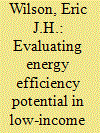

|
|
|
|
|
| Summary/Abstract |
This study presents a new approach to evaluating energy efficiency potential that provides a more accurate, granular, and flexible estimate of the cost-effective energy efficiency potential in households of various income ranges.
Results from this work estimate that in U.S. single-family households with income less than 200% of the federal poverty level, energy efficiency packages tailored to maximize net present value could result in an estimated $13 billion per year in energy cost savings, or $670 per year for an average household, corresponding to about 1 EJ (0.9 quads) of annual primary energy savings. These types of metrics can be estimated for other geographies (regions, states, and counties) and for other ranges of household income.
|
|
|
|
|
|
|
|
|
|
|
|
|
|
|
|
| 6 |
ID:
179739
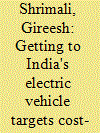

|
|
|
|
|
| Summary/Abstract |
In the context of India's ambitious electric vehicle targets, we examine two related questions. First, based on lifetime costs, which electric vehicles need to be subsidized? Second, based on lifetime subsidies, which subsidy option would be the most cost-effective? We find that electric two-wheelers, three-wheelers, four-wheeler-taxis, and buses do not need to be subsidized given that they are already cost competitive with comparable vehicles using internal combustion engines. We also find that personal cars and long-haul trucks need to be subsidized significantly, by one-third to one-half of the upfront costs. Finally, we find that an upfront subsidy is the most cost-effective subsidy option, followed by a per kilometer subsidy, which is effectively 19–31% costlier, whereas financing subsidies are found to be the least cost effective. Our results suggest that a cost-effective policy in India would be to subsidize only personal cars and long-haul trucks, while using the upfront subsidies.
|
|
|
|
|
|
|
|
|
|
|
|
|
|
|
|
| 7 |
ID:
179737


|
|
|
|
|
| Summary/Abstract |
Carbon capture, utilization and storage (CCUS) represents a set of technologies essential to meeting ambitious mid-to late-century decarbonization goals. Yet deployment of CCUS has been slow, with fewer than 20 large-scale facilities operating worldwide in 2019. We estimate the total and marginal cost of constructing and operating new CCUS facilities and associated infrastructure to reduce carbon dioxide (CO2) emissions from current and planned industrial facilities on the Texas and Louisiana Gulf Coast. We compare these cost estimates to scheduled CCUS tax incentives through 2026 under section 45Q of the U.S. Internal Revenue Code to quantify cost-effective emissions abatement. Our analysis measures the cost-reducing potential of economies of scale in regional CO2 pipeline networks. We also compare CCUS costs to one measure of the benefits of carbon capture, the social cost of carbon. Results suggest that U.S. federal tax incentives currently in place through 2026 could justify between 3.3 million and 77.6 million tons of annual CCUS in the Gulf region, depending on the choice of storage technology and the degree of pipeline network coordination. Finally, we highlight several potential policy barriers that may explain low adoption of CCUS in the Gulf Region and elsewhere.
|
|
|
|
|
|
|
|
|
|
|
|
|
|
|
|
| 8 |
ID:
132689
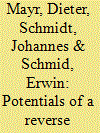

|
|
|
|
|
| Publication |
2014.
|
| Summary/Abstract |
Photovoltaic (PV) has developed to one of the most promising technologies for renewable electricity generation. The Austrian government currently provides subsidies for roof-top PV systems through a constant, administratively determined feed-in tariff or an investment co-funding. In both subsidy schemes, applications are approved on a first-come, first-served basis. There are concerns about (i) the selection of suitable roofs for PV systems, and (ii) allocating subsidies among applicants to deploy roof-top PV systems cost-effectively. Thus we analyze the potentials of a simple discriminative first-price reverse auction application scheme. Applicants define individually the required level of subsidy and those with the lowest request for subsidies are selected. In an ex-post analysis, we evaluate the potentials of such a scheme in increasing power output and saving public spending for the federal state of Vorarlberg in Austria. Results indicate a potential increase of cumulated produced electricity between 15% and 18% in comparison to the current policy. In addition, a reverse auction-based system would lead to savings of public spending per kWh between 20% and 41%.
|
|
|
|
|
|
|
|
|
|
|
|
|
|
|
|
|
|
|
|
|